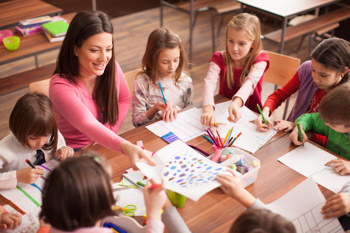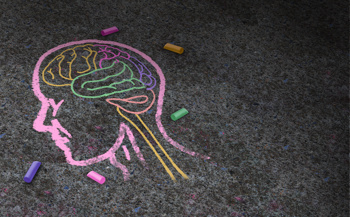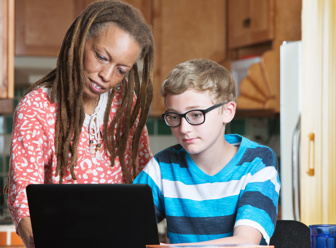
Children’s mental health – What is it?
Mental health in children is just as important to their safety and wellbeing as their physical health. Mind defines mental health as individual, cognitive, behavioural, and emotional wellbeing that everyone has including every child and young person.
A child’s mental health can impact all aspects of their life such as their educational attainment and academic success, relationships with others, and their physical wellbeing.
Like mental health in general, children’s mental health can also change over time with various degrees of seriousness due to different social factors and determinants of health. Mental health issues refer to mental health conditions, problems, and illnesses that may or may not be medically diagnosed.
In recent years, children’s mental health in general has been declining rapidly. In 2022/2023 alone over half of all Childline’s counselling sessions were related to mental or emotional health and wellbeing.
Why is Children’s health and wellbeing important?

Children’s mental health and wellbeing are important as they can lay the foundations for a child’s future development and success.
Having good mental health supports children in managing emotions, forming positive relationships, and learning effectively. This, in turn, also helps to develop their resilience to navigate challenges and adversity.
There can be many benefits to positive mental health and wellbeing in children and young people including:
1. Improved academic performance
Having good mental health enables better concentration, memory, and cognitive abilities which all help establish great success in a child’s education.
2. Emotional Regulation
A positive mental health and wellbeing allow children to manage their emotions better and understand how emotions and wellbeing can fluctuate, and the best ways to cope with this. This, in turn, reduces the likelihood of behavioural problems and conflicts.
3. Self-esteem
Positive mental health in children boosts self-confidence and self-esteem to enable children to have a positive self-image and pursue their goals with confidence.
4. Creativity and innovation
A healthier mind in a child also helps to foster better creativity and innovation allowing children to explore their hobbies, interests, and passions more freely.
5. Better long-term wellbeing
Essentially educating children from a young age about different emotions and how to manage them sets the foundations and provides the skills for better mental health and wellbeing in the future.
Mental health problems in children – What are the factors?
Like mental health in adults, children’s mental health can increase and decrease all the time. There are many factors that influence a child’s mental health.
In 2021-2022 alone over 734,000 children were referred to children and young people’s mental health services. This is a massive 84% rise from 2018-2019.
Any child or young person can develop mental health problems; however, research shows some factors that impact children’s and young people’s mental health in the long term. The list below shows some of the factors that impact and cause mental health issues in children and young people.
1. Abuse and Neglect
Any child who has experienced emotional abuse may be more likely to develop anxiety and depression compared to children who have not experienced types of abuse. This, in turn, can make children more vulnerable to developing more than one mental health condition at a given time.
2. Disabilities and learning difficulties
Disabilities and learning difficulties can cause mental health issues in children as it can lead to lower self-confidence and difficulty forming social connections leaving them excluded and isolated, and at a higher risk of developing mental health issues.
3. Living in Care
Children living in care can be at more risk of declining mental health as they can be in care for many different reasons. Whether it’s due to abuse, neglect, bereavement, or behavioural problems, living in care can be daunting and isolating. This, in turn, can leave children feeling lonely, lowering their self-esteem and ultimately their mental health and wellbeing.
4. Being a young carer
Another risk factor in a child’s mental health is being a young carer. Becoming a part-time or full-time young carer can be intense and highly exhausting. It also makes a young carer’s lifestyle very different compared to another child.
Young carers must take on a lot more responsibility whilst still attending school, this increased pressure can create great stress which in turn can cause a child’s mental health to decline.
5. Family environment
Living in a family environment which is positive and supportive can significantly impact a child’s mental health. They will often feel more comfortable and safer allowing them to have better quality relationships with families, reduce stress, worry, and anxiety compared to a family environment that’s argumentative, disruptive, and unstable.
6. School environment
School environments are another key area that impacts a child’s mental health and wellbeing. Not having strong peer relationships can influence a child’s sense of belonging, self-esteem, and emotional resilience. This often can lead to children being isolated, hating school, as well as increasing the likelihood of being bullied.
7. Cultural and Societal influences
Cultural norms, societal attitudes towards mental health, and access to culturally competent care can influence how children perceive and address their mental health needs.
Stereotypes around talking about emotions can make it harder for some children to ask for help and support when needed, which in turn can leave children continuing to suffer on their own without any support.
Arguably many different factors can impact a child’s mental health. The wider social determinants of health and socioeconomic factors including education, housing, and money are often out of a child’s control and can have a significant impact on their mental health and wellbeing.
Negative impacts of social media, long-term impacts of COVID-19, and an inability to access schools and their resources also negatively can impact a child’s mental health and wellbeing.
Children’s mental health crisis – How has it happened?

In the last year alone, there were over 32,000 emergency and urgent referrals to CAHMS. Previously, prior to Covid, it was just over 21,000. Since covid therefore there has been a massive increase in emergency referrals of 53%. This means that more than 600 mentally ill children a week are deteriorating to such a state that they have reached crisis point.
Many children who need emergency care have been stuck on waiting lists for an average of five months, and in some extreme cases, some have been waiting up to two years.
One of the main reasons for the long waiting times is due to limited budgets and resources. MPs and health leaders have described these NHS figures as a devastating explosion, insisting that ministers take urgent action to provide better-targeted support for every child in need.
Here the long-term impacts of covid and the cost-of-living crisis has created many financial stressors, poverty, and wider health and social care disparities in communities creating additional challenges and impacts on children’s mental health.
Last year over 130,000 children were in temporary accommodation, not only can this generate stress and worries for the child, it can also make them more susceptible to bullying and further social isolation at school. Some children will also have to move schools depending on where temporary accommodation can be found, increasing their isolation and loneliness further.
What is certain is that the UK government and The Department of Health and Social Care have acknowledged that this cannot continue and are determined to support children and young people with their mental health.
They have announced £2.3 billion a year will go into funding NHS mental health services to help expand the number of mental health support teams in schools to reach at least 50% of pupils in England by the end of March 2025.
Mental health conditions in children – What are they?

To address the heart of the problem one of the first steps needed is to understand the different mental health conditions, problems, and illnesses children and young people can experience.
By having this information and understanding of what condition or conditions are rising the most, communities, local authorities, support services, and primary and secondary care services can work together to better establish and decide what support is needed where.
For children and young people some of the most common mental health conditions include stress, anxiety, depression, eating disorders, as well as Attention Deficit Hyperactivity Disorder (ADHD).
A recent report has shown that mental health conditions in children not only differ in age but in gender too.
For girls emotional disorders are more common and often are at their highest between the ages of 17 to 19 years. Boys on the other hand had more behavioural and hyperactivity conditions such as Attention Deficit Hyperactivity Disorder (ADHD) With the most common in ages 11 to 16.
The evidence from the Mental Health of Children and Young People Survey concludes that gender differences in the rate of mental health increase at the critical period of adolescence. The data concluded that mental health needs in boys and young men peak in early adolescence. Girls and young women, on the other hand, experience a steady increase in mental health needs from primary school through adolescence into young adulthood.
Mental health support for children – What is available?
In response to the mental health crisis in children currently the departments of health and social care across England, Scotland, Wales, and Northern Ireland have been developing and amending their mental health and health and social care acts to better accommodate the mental health needs of children and young people.
This also includes providing statutory advice and guidance for schools to not only notice signs of mental health decline but how to support and respond to the signs too.
Currently there are lots of services that can help children talk about their feelings including Childline’s message boards, online services, as well as online toolboxes that provide teachers and support workers ideas to encourage children to express themselves including mood journals and buddy zones.
Young Minds Crisis Messenger is also gaining more popularity for older children and young people allowing them to text someone for support rather than have a face to face conversation. This enables children and young people to feel more comfortable to talk about their feelings and use support services at their own pace.
Another way many children and young people get support is by visiting their GP to then be referred to a mental health nurse or specialist. As this is one of the most common routes, referrals and waiting times keep rising continuously, leaving mental health teams massively overworked, stretched, and burnout.
In a recent YoungMinds survey 55% of 16- to 25-year-olds said they had seen their GP about their mental health at some point in their lives and 34% of those young people who did get referred into NHS Services were not accepted into treatment mainly due to limited resources.
They also found that more than two thirds of young people would prefer to access mental health support without going through their GP but struggle to know where to go.
It is clear therefore despite there being lots of resources online to help provide mental health support in children and young people, most only know about the more traditional routes which are becoming more saturated leaving long waiting times and increases the risk of further deterioration in a child’s mental health.
Social prescribing for children – How can it improve mental health in children and young people?

As discussed above, pressure on children and adolescent mental health services is continuing to grow, long waiting lists and times are rising and more children and young people are getting referrals rejected due to limited resources and not meeting the high criteria for specialist support.
Funding on mental health support may have increased, however, the focus so far has been predominantly acute care rather than preventative and early intervention. Social prescribing for children and young people is an example of a preventative and early intervention approach that bridges the gap for mental health provision.
Here children and young people can be supported to access better non-clinical services in their communities to improve their mental health and wellbeing. Every child referred can work with a Social Prescribing Link Worker to co-produce their social prescription on what matters to them.
“Social prescribing can play an important role in supporting young people who are struggling with their mental health, by connecting them to non-medical support that makes a huge difference. Link workers have time to understand young people’s needs and what matters to them, and then work with them to create a personalised plan…Social prescribing has enormous potential for this age-group, and there will be lots of opportunities to learn from the projects that are developing across the country.”
Children’s social prescribing – where is the evidence?
In Barnardo's’ recent report, The Missing Link – Social Prescribing for Children and Young People, it illustrates how social prescribing and Link Workers play a vital role in identifying the right services or activities a child needs to improve their mental health.
The report demonstrates that for every £1 spent on social prescribing around £1.80 worth of long-term benefits and improvements in mental health can be provided through reducing the use and need of primary and secondary care services.
They also demonstrate that if social prescribing was fully integrated within England for both children and adults, the need for GP appointments would be reduced by up to 3% which annually would free up 3 million appointments.
It has been proven that children's social prescribing not only improves their mental health and wellbeing but also their school attendance and engagement. It also helps to build social connections with society whilst boosting their self-esteem and reducing their loneliness and isolation to build a stronger sense of belonging.
Within Barnardo’s report it also highlights the benefits of engaging children and young people in both green and blue social prescribing, the process of referring individuals to services situated in nature or water such as gardening or kayaking. Here children and young people can increase their physical activity, improve their wellbeing, whilst learning new skills to make the groups more fun and exciting which in turn relax children and young people to feel more relaxed about talking about their feelings.
One example of social prescribing in children is the LINK service based in Cumbria and delivered by Barnardo’s. Here the LINK Service has supported over 320 children and young people aged 5 to 19 since March 2020. The social prescribing service provides ways to connect children and young people to their family, friends, and peers to help them with a wide range of reasons for referral which are impacting their health and wellbeing.
Since the start of the project 96% of these referrals have been accepted, offering primary, secondary, and acute care services a better preventative approach to children’s mental health.
Social Prescribing for children and young people – How can Access Elemental help?

At Access Elemental Social Prescribing, we know that social prescribing for CYP is still in its infancy compared to social prescribing at an adult level, but we know the potential and difference it can and will make both now and in the future.
Despite there being additional factors to consider when implementing social prescribing in children and young people including capacity, funding, ages, safeguarding, and confidentiality, the impact this will have when integrated correctly is huge.
Both children and young people’s mental health and wellbeing can improve without long waiting times, parents and guardians can be left reassured they are receiving mental health support that is preventative and adaptable to their child’s needs, as well as be happy that if they require more specialist care, they will still receive some mental health support beforehand to prevent any further deterioration.
Using digital social prescribing platform for children and young people
At Access Elemental Social Prescribing we know that in order to build up awareness and success you need data and evidence, and to do this you need better ways of measuring, making, and tracking referrals to make better data-led decisions across your multidisciplinary team.
Our social prescribing platform centralises all information in one place to make it easier to track every individual’s social prescribing journey. We know and understand that there can be many reasons for referrals and different interventions needed.
To make finding these interventions easier our platform operates a pre-approved directory of services which allows Link Workers and support workers to locate services that best meet the child’s or young person’s needs both now and, in the future, as they change. Here children and young people are referred to safe and assured pathways that matter to them with no risk of being referred to an outdated service which could lower their self-esteem further.
For more information on our social prescribing software today. Contact us and find out first-hand how we adapt our platform to best support your community’s and school’s needs to overcome the mental health crisis in children to deliver better timely, higher quality, and preventative mental health support bot now and in the future.
